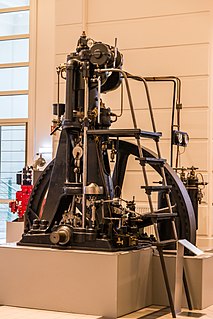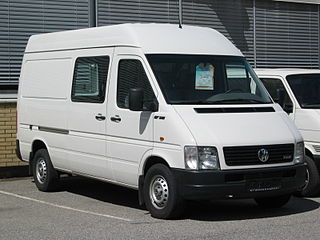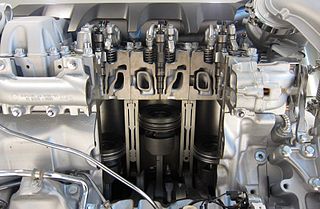Related Research Articles

The diesel engine, named after Rudolf Diesel, is an internal combustion engine in which ignition of the fuel is caused by the elevated temperature of the air in the cylinder due to mechanical compression; thus, the diesel engine is a so-called compression-ignition engine. This contrasts with engines using spark plug-ignition of the air-fuel mixture, such as a petrol engine or a gas engine.
A stratified charge engine describes a certain type of internal combustion engine, usually spark ignition (SI) engine that can be used in trucks, automobiles, portable and stationary equipment. The term "stratified charge" refers to the working fluids and fuel vapors entering the cylinder. Usually the fuel is injected into the cylinder or enters as a fuel rich vapor where a spark or other means are used to initiate ignition where the fuel rich zone interacts with the air to promote complete combustion. A stratified charge can allow for slightly higher compression ratios without "knock," and leaner air/fuel ratio than in conventional internal combustion engines.

The Volkswagen Transporter LT is the largest light commercial panel van produced by Volkswagen from 1975 to 2006, before being replaced by the Crafter. Two generations were produced.
The GM Ecotec engine, also known by its codename L850, is a family of all-aluminium inline-four engines, displacing between 1.4 and 2.5 litres. While these engines were based on the GM Family II engine, the architecture was substantially re-engineered for the new Ecotec application produced since 2000. This engine family replaced the GM Family II engine, the GM 122 engine, the Saab H engine, and the Quad 4 engine. It is manufactured in multiple locations, to include Spring Hill Manufacturing, in Spring Hill, Tennessee while the engine block and cylinder heads are cast at Saginaw Metal Casting Operations in Saginaw, Michigan.

Common rail direct fuel injection is a direct fuel injection system built around a high-pressure fuel rail feeding solenoid valves, as opposed to a low-pressure fuel pump feeding unit injectors. High-pressure injection delivers power and fuel consumption benefits over earlier lower pressure fuel injection, by injecting fuel as a larger number of smaller droplets, giving a much higher ratio of surface area to volume. This provides improved vaporization from the surface of the fuel droplets, and so more efficient combining of atmospheric oxygen with vaporized fuel delivering more complete combustion.

Gasoline direct injection (GDI), also known as petrol direct injection (PDI), is a mixture formation system for internal combustion engines that run on gasoline (petrol), where fuel is injected into the combustion chamber. This is distinct from manifold fuel injection systems, which inject fuel into the intake manifold.

The Volkswagen G60 and G40 engines are inline-four cylinder automobile petrol engines, which uses a specific method of forced induction - by way of a scroll-type supercharger. The G60 engine was formerly manufactured by the German automaker Volkswagen Group, and was installed in a limited number of their 'hot hatch' cars from their Volkswagen Passenger Cars marque from August 1988 to July 1993.
The PSA Group sells a variety of diesel automobile engines with the HDi designation. Earlier versions were exclusive to Peugeot and Citroën. In 1998, PSA entered into a joint venture with the Ford Motor Company to produce a range of new diesel engines. The joint venture makes identical engines which are fitted to a variety of vehicles from a range of car manufacturers. The engines are assembled in production plants in the cities of Trémery and Douvrin for PSA in France, at the Ford Dagenham plant in the UK, and Volvo Engine Plant in Skövde Sweden when Volvo was still under Ford ownership.

The Volvo D5 is a type of turbocharged diesel engine developed by Volvo Cars for use in its passenger cars. The D5 engine is based on the Volvo Modular petrol engine. The D5 displaces 2.4 liters; a smaller series of two-litre engines were developed in 2010 and marketed as the Volvo D3 and D4.

The Volkswagen D24 engine is a 2.4-litre inline-six-cylinder (R6/I6), naturally aspirated diesel engine, formerly manufactured by Volkswagen Group from 1978 to 1995.
The Volkswagen D24TIC is a 2.4-litre inline-six-cylinder (R6/I6) single overhead camshaft (SOHC) diesel engine, formerly manufactured by Volkswagen Group from August 1986 to December 1998.
The SDI engine is a design of naturally aspirated (NA) direct injection diesel engine developed and produced by Volkswagen Group for use in cars and vans, along with marine engine and Volkswagen Industrial Motor applications.
The EA827 family of petrol engines was initially developed by Audi under Ludwig Kraus leadership and introduced in 1972 by the B1-series Audi 80, and went on to power many Volkswagen Group models. This is a very robust water-cooled engine configuration for four- up to eight- cylinders, and is still in production. In Brazil this engine was produced under the name Volkswagen AP AP.
A Heron cylinder head, or simply Heron head, is a design for the combustion chambers of the cylinder head on an internal combustion piston engine. The head is machined flat, with recesses only for inlet and exhaust valves, spark plugs, injectors and so on. The combustion chamber itself is contained within a dished depression in the top of the piston. The Heron head is suitable for petrol and diesel engines, for ohv and ohc valve-gear, and for small and large engine displacement capacities.